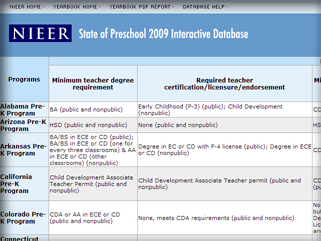
Does State Pre-K Effectively Serve English Language Learners?
June 4, 2010
As the population of young children changes, there has been an increase in research focusing on English Language Learners (ELLs). For The State of Preschool 2009 yearbook, data were collected on the number of ELLs in state-funded prekindergarten programs, support services for ELLs and their families, and whether or not programs identify having non-English speaking family members as a risk factor for eligibility.
Twenty-four out of 38 states (63 percent) with state-funded prekindergarten initiatives were able to report the number of ELL students in their programs. Of these states, Texas reported the largest number of ELLs enrolled in their pre-K program with more than 85,000 children, while West Virginia reported having only 26 ELLs enrolled. To see the other state-funded programs that were able to report ELL enrollment, click on the image below.
During the 2008-2009 school year, 17 pre-K programs identify having non-English speaking family members as a risk factor used – in addition to income status – to determine eligibility. In addition, 31 pre-K initiatives in 24 states have at least one support service for ELLs and their families. Examples of these support services include permitting bilingual classes in pre-K, presenting information to parents in their primary language, or having translators available if children do not speak English. Nineteen initiatives in 16 states have policies that do not regulate services for ELLs.
For complete information on state-funded preschool programs, go to the 2009 Yearbook Interactive Database.
— Dale J. Epstein
Assistant Research Professor, NIEER

About NIEER
The National Institute for Early Education Research (NIEER) at the Graduate School of Education, Rutgers University, New Brunswick, NJ, conducts and disseminates independent research and analysis to inform early childhood education policy.
